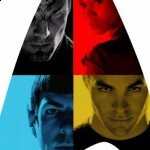Confession: I have never sat through an entire episode of Star Trek, nor seen any of the ten prior films belonging to the franchise up until this latest reboot. As scientifically proven to be true with 4 out of 5 people, I consider myself a Star Wars fan if anything, making me somewhat proud of such ignorance…that is until now. In Star Trek XI, Director J.J Abrams wipes the slate clean and achieves the seemingly impossible; he’s made Star Trek ‘cool’. Regardless of whether you’re fluent in Klingon or not, Abrams’ reboot is an exciting sci-fi action extravaganza well worth the Trek.
Captained by the malicious Nero (Eric Bana), a large alien spacecraft mysteriously emerges from a ‘space thunderstorm’ before attacking heavily outclassed Federation ship. Surviving the attack is Winona Kirk, returning to Earth to raise her newborn son James T. Kirk (Chris Pine), who grows up to be a rebellious troublemaker. Meanwhile, an exceptionally bright half-human half-Vulcan student by the name of Spock (Zachary Quinto) is struggling to fit in because of his impure bloodline. Hoping to prove something to themselves and their naysayers, the two join the space cadets where they are both fast tracked into duty on-board the newly commissioned U.S.S. Enterprise. Their first mission is to aid in the recovery of a Federation ship, whose last transmission mentioned a ‘space thunderstorm’ much like the one from the day Kirk was born.
![STAR TREK 2008 star trek 0161 303x192 custom Star Trek [2009] (Review)](/wp-content/uploads/2008_star_trek_0161-303x192-custom.jpg)
|
Best described as an origin story, Star Trek is more concerned with introducing the franchise to newcomers than it is just rewarding its loyal fanbase (who will no-doubt see the film anyway). In order to ease newbies in, the narrative has been heavily modified and characters altered to be more relateable to a 21st century audience. It works like a charm; the film doesn’t overwhelm you with a franchise that has been nearly fifty years in the making, allowing us to get to know the characters at the same time as they get to know each other. Yet fans needn’t worry as there seems to be an abundance of ‘in’ jokes in the film, something I deduced from the impromptu laughter and applause of the costumed Trekkies in the back row. By the sounds of it, they also thoroughly enjoyed Leonard Nimoy’s extended-cameo as the elderly Spock, a role he has been playing since 1966.
But it is the young Spock who sits central to the film, portrayed with great nuance by Zachary Quinto of TV’s Heroes. He shares the role of protagonist with a charismatic Chris Pine as the arrogant Captain Kirk, whose rebellious childhood couldn’t contrast more with Spock’s systematic academic upbringing, which foreshadows their future personality clash on-board the U.S.S Enterprise. Even though the story here firmly revolves around the rocky origins of their friendship, the dynamic crew onboard the Enterprise still have a great presence. Fuelled by consistently humorous dialogue, the over-excitable Russian navigator Chekov (Anton Yelchin), pessimistic medical chief McCoy (Karl Urban) and attention-seeking Scottish engineer Scotty (a return to form for Simon Pegg) are each a joy to watch.
The only character hard done by is the film’s villain Nero, whom despite being portrayed with great menace by Eric Bana, isn’t given nearly enough screen time to truly justify his wickedness. This can be seen as a consequence of Abrams’ overextending his reach, as his attempt to get all the introductions done in a single sitting sees the primary narrative get brushed over. To save on time, the plot employs too many unlikely conveniences to jerk its way forward. There’s also the needlessly tacked-on love triangle between Spock, Kirk and Uhura, which gets about as sensual as the line: “I’ll monitor your vitals…”.
![2008_star_trek_0231 2008 star trek 0231 341x184 custom Star Trek [2009] (Review)](/wp-content/uploads/2008_star_trek_0231-341x184-custom.jpg)
|
Star Trek truly shines when it delivers the Sci-fi action, boasting some of the most spectacular computer generated effects seen to date. Trekkies will no doubt take great pleasure in seeing their beloved universe come to life so vividly. One sequence in which Captain Kirk and Hikaru take a freefall dive through a planet’s atmosphere is nothing short of breathtaking. Abrams captures the live action using the same raw and twitchy camera work he employed in TV’s Alias and Lost, where multiple wiz pans and frequent lense flares create an unmatched energy and urgency on screen. That being said, the camera continues to shake incessantly during the most casual of conversations, leaving me to question whether this is purposefully dynamic cinematography or just a camera operator suffering from hypothermia.
Verdict:
An endlessly exhilarating and engaging ride regardless of its narrative flaws, Star Trek is one of the best sci-fi films of the last decade, and that’s coming from someone who has never Trekked before.
Star Trek hits Australian cinemas May 7th.
 Follow the author Anders Wotzke on Twitter.
Follow the author Anders Wotzke on Twitter.
![Star Trek [2009] (Review)](/wp-content/uploads/2008_star_trek_wallpaper_0301.jpg)













![The Girl with the Dragon Tattoo [2011] (Review)](/wp-content/uploads/girl-with-dragon-tattoo-2011-poster11-e1326691158273-150x150.jpg)
